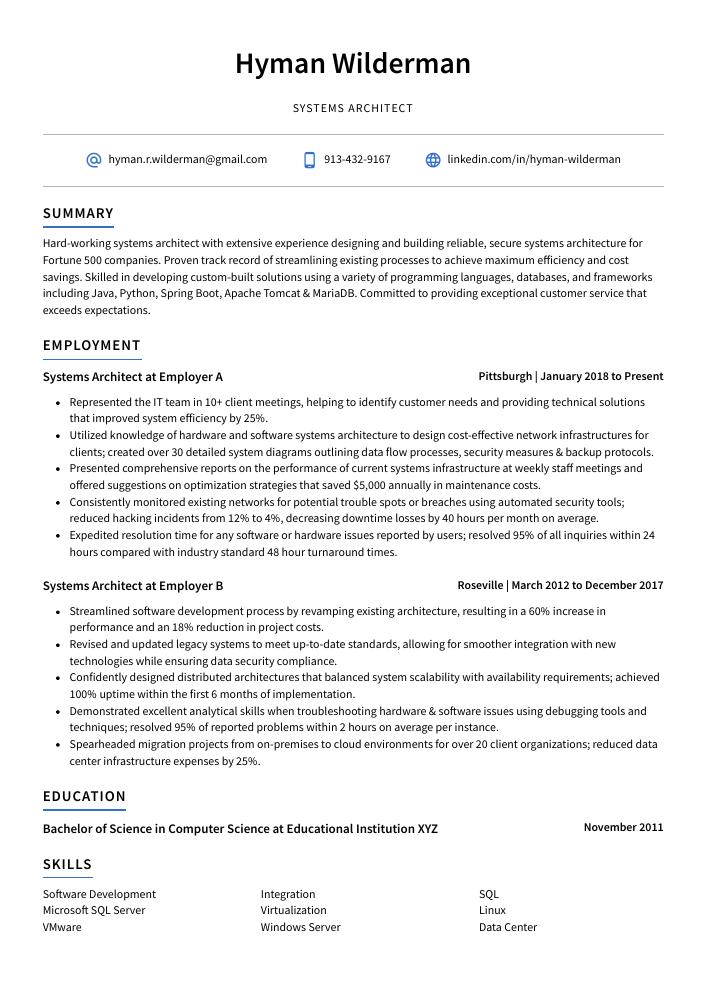Systems Architect Resume Guide
Systems Architects design, implement, and maintain computer systems. They analyze the current system architecture to identify areas of improvement while ensuring that new technologies are compatible with existing ones. They also create a plan for future growth and development of the system architecture in order to meet changing business needs.
You have the experience and technical knowledge to design complex IT systems, yet employers don’t know who you are. To make them aware of your capabilities, create a resume that stands out from the rest.
This guide will walk you through the entire process of creating a top-notch resume. We first show you a complete example and then break down what each resume section should look like.
Table of Contents
The guide is divided into sections for your convenience. You can read it from beginning to end or use the table of contents below to jump to a specific part.
Systems Architect Resume Sample
Hyman Wilderman
Systems Architect
[email protected]
913-432-9167
linkedin.com/in/hyman-wilderman
Summary
Hard-working systems architect with extensive experience designing and building reliable, secure systems architecture for Fortune 500 companies. Proven track record of streamlining existing processes to achieve maximum efficiency and cost savings. Skilled in developing custom-built solutions using a variety of programming languages, databases, and frameworks including Java, Python, Spring Boot, Apache Tomcat & MariaDB. Committed to providing exceptional customer service that exceeds expectations.
Experience
Systems Architect, Employer A
Pittsburgh, Jan 2018 – Present
- Represented the IT team in 10+ client meetings, helping to identify customer needs and providing technical solutions that improved system efficiency by 25%.
- Utilized knowledge of hardware and software systems architecture to design cost-effective network infrastructures for clients; created over 30 detailed system diagrams outlining data flow processes, security measures & backup protocols.
- Presented comprehensive reports on the performance of current systems infrastructure at weekly staff meetings and offered suggestions on optimization strategies that saved $5,000 annually in maintenance costs.
- Consistently monitored existing networks for potential trouble spots or breaches using automated security tools; reduced hacking incidents from 12% to 4%, decreasing downtime losses by 40 hours per month on average.
- Expedited resolution time for any software or hardware issues reported by users; resolved 95% of all inquiries within 24 hours compared with industry standard 48 hour turnaround times.
Systems Architect, Employer B
Roseville, Mar 2012 – Dec 2017
- Streamlined software development process by revamping existing architecture, resulting in a 60% increase in performance and an 18% reduction in project costs.
- Revised and updated legacy systems to meet up-to-date standards, allowing for smoother integration with new technologies while ensuring data security compliance.
- Confidently designed distributed architectures that balanced system scalability with availability requirements; achieved 100% uptime within the first 6 months of implementation.
- Demonstrated excellent analytical skills when troubleshooting hardware & software issues using debugging tools and techniques; resolved 95% of reported problems within 2 hours on average per instance.
- Spearheaded migration projects from on-premises to cloud environments for over 20 client organizations; reduced data center infrastructure expenses by 25%.
Skills
- Software Development
- Integration
- SQL
- Microsoft SQL Server
- Virtualization
- Linux
- VMware
- Windows Server
- Data Center
Education
Bachelor of Science in Computer Science
Educational Institution XYZ
Nov 2011
Certifications
Certified Systems Architect (CSA)
International Association of Systems Architects
May 2017
1. Summary / Objective
Your resume summary or objective should be a concise overview of your qualifications as a systems architect. Highlight the most relevant skills and experiences you have that make you an ideal candidate for this position, such as experience designing complex IT infrastructures, knowledge of multiple programming languages, and expertise in cloud computing technologies. Showcase how these qualities can benefit the company if they hire you.
Below are some resume summary examples:
Detail-oriented systems architect with 10+ years of experience in designing, developing and managing complex IT systems. Proven track record of success building high-performance cloud solutions for businesses from the ground up. Skilled at leading project teams to design innovative architectures that are secure, scalable, cost-effective and easy to maintain. Specialized expertise in DevOps, AWS/Azure cloud computing environments and enterprise integration technologies.
Determined systems architect with 8+ years of experience in designing, developing and deploying IT architectures for large-scale projects. Specialized in integrating existing systems into a unified platform that meets the client’s requirements. At ABC Company, designed an automated network monitoring system to improve productivity by 25%. Excellent communication skills and ability to work closely with engineering teams to ensure successful project delivery.
Skilled systems architect with 8+ years of experience designing, developing and implementing complex IT systems. Adept at creating system architecture blueprints to maximize scalability, security and performance. Committed to staying on top of the latest technologies for emerging trends in software design. Currently looking for a challenging opportunity where I can utilize my skillset to contribute towards ABC Tech’s mission-critical projects.
Passionate Systems Architect with 8+ years of experience in designing, developing, and maintaining enterprise solutions. Skilled at creating cost-effective technology architectures that align to business objectives. Proven track record of delivering projects on time and within budget while providing exceptional customer service. Experienced in leading cross-functional teams through all phases of the software development life cycle (SDLC).
Accomplished systems architect with 10+ years of experience designing, building and implementing complex systems for a variety of organizations. Skilled in leading and supporting IT teams to develop solutions that meet customer requirements while staying within budget constraints. Looking to join ABC Tech as an architect where I can use my technical knowledge and strategic vision to create efficient system architectures.
Committed systems architect with 10+ years of experience designing, developing and implementing complex systems architectures for the public sector. Seeking to join ABC Systems where I can utilize my expertise in IT security compliance and cloud computing infrastructure design to create secure and resilient solutions for their clients. Achieved an on-time system delivery rate of 95% as well as a cost savings of 20%.
Reliable and detail-oriented systems architect with 8+ years of experience designing and developing complex IT solutions for leading organizations. Experienced in cloud computing, distributed architectures, data storage & processing technologies, as well as system integration & security. Looking to join ABC Tech to leverage my expertise in building secure and scalable network architecture that meets customer needs.
Well-rounded systems architect with 10+ years of experience developing, deploying and managing enterprise-level IT solutions. Proven track record in driving successful business outcomes through the design and implementation of secure cloud-based systems. Seeking to bring innovative ideas, cost savings strategies and technical expertise to ABC as a senior systems architect.
2. Experience / Employment
For the experience section, you should list your employment history in reverse chronological order, with the most recent job listed first.
When talking about what you did at each role, use bullet points to make it easier for the reader to digest the information quickly. You want to provide as much detail as possible and include any quantifiable results that were achieved due to your efforts.
For example, instead of saying “Designed new systems,” you could say, “Developed a cloud-based system architecture capable of scaling up or down based on customer demand; reduced costs by 25% while increasing performance by 20%.
To write effective bullet points, begin with a strong verb or adverb. Industry specific verbs to use are:
- Designed
- Implemented
- Configured
- Analyzed
- Optimized
- Monitored
- Resolved
- Documented
- Automated
- Integrated
- Upgraded
- Troubleshot
- Tested
- Debugged
- Evaluated
Other general verbs you can use are:
- Achieved
- Advised
- Assessed
- Compiled
- Coordinated
- Demonstrated
- Developed
- Expedited
- Facilitated
- Formulated
- Improved
- Introduced
- Mentored
- Participated
- Prepared
- Presented
- Reduced
- Reorganized
- Represented
- Revised
- Spearheaded
- Streamlined
- Structured
- Utilized
Below are some example bullet points:
- Debugged and troubleshot existing system architectures to identify and resolve technical issues, resulting in an 80% decrease in downtime over the past year.
- Assessed current IT infrastructure needs of clients, designed custom solutions that met their requirements and achieved a cost-savings of $50K+ per project on average.
- Integrated multiple hardware/software components into complex systems architectures while adhering to security protocols; reduced vulnerability risks by 45%.
- Structured efficient networks with reliable scalability for organizations ranging from small businesses to Fortune 500 companies within budget constraints and set timeframes; completed projects up to 2 weeks ahead of schedule every quarter since 2019.
- Effectively communicated network designs, implementation strategies and potential benefits across teams via presentations & documentation; significantly improved team collaboration & interdepartmental coordination efforts as well as shared understanding about architecture objectives amongst stakeholders.
- Developed secure architectures and systems for clients, increasing system security by 25% while reducing downtime by 12%.
- Evaluated existing computer networks to identify potential issues and improve performance; reduced network latency times by 50% in the last quarter.
- Upgraded hardware and software components of client’s infrastructures according to industry best practices, ensuring that all systems were running at optimal levels.
- Meticulously monitored the data flow between different business units within a company’s IT infrastructure, resulting in smoother communication across teams with no disruption or delays in service delivery.
- Introduced innovative solutions such as cloud computing into clients’ systems for enhanced scalability and improved resource management; successfully implemented 10 projects using this technology over six months period.
- Reorganized and optimized system architecture for 10+ organizations, resulting in an average of 30% cost savings.
- Documented complex systems architectures & technical requirements for mid-to-large scale projects; compiled over 500 pages of detailed process flow diagrams, software designs and user interface mockups.
- Independently identified potential areas of improvement in existing software infrastructure environments across multiple clients, ultimately leading to a reduction of deployment time by 40%.
- Analyzed business needs, customer data trends and industry best practices when creating new or improved technology solutions that drove productivity gains up by 20%.
- Designed streamlined IT processes with focus on scalability and flexibility while adhering to organizational security protocols; achieved 100% compliance rate within the first quarter after implementation.
- Tested and evaluated existing IT systems for performance, security, scalability and reliability; improved system speed by 75% over a 6 month period.
- Advised technical teams on best practices when designing, developing and deploying new applications in the cloud environment; recommended appropriate technologies that resulted in saving an estimated $4 million per year.
- Participated actively in software architecture reviews for several projects to ensure quality assurance standards were met throughout design & development phases; identified 27 potential issues before coding stage was completed.
- Thoroughly documented system designs and implemented UX/UI best practices to make sure end user experience is intuitive and seamless across multiple platforms such as desktop, mobile web & app versions of the same application(s).
- Monitored performance metrics daily using analytics tools such as Splunk or Google Analytics to identify trends which could potentially lead to further optimization of existing processes & workflows within the organization’s infrastructure landscape.
- Formulated and implemented complex systems architecture solutions on multiple projects, resulting in a 15% improvement of system performance.
- Mentored junior team members in developing creative technical designs for optimal infrastructure scalability; trained 3 new hires over the course of 6 months.
- Resolved numerous production issues related to software integration, hardware configuration & data transfer protocols within 24 hours or less across 12+ client engagements.
- Coordinated cross-functional teams to install and test new operating systems and applications; collaborated with 50+ IT personnel to achieve successful deployment within budget targets (+$50K).
- Diligently monitored server uptime/downtime levels via real-time analytics tools, reducing unplanned outages by 30%.
- Facilitated the successful integration and implementation of over 20 complex networking systems, reducing total network downtime by 40%.
- Reduced long-term costs associated with IT infrastructure maintenance by revamping the existing architecture to create a more efficient system; achieved $250,000 in savings for the organization within 12 months.
- Achieved extensive knowledge and experience in designing/maintaining diverse range of networks including LANs, WANs, SANs and VoIP systems; configured various types of routers & switches as required.
- Configured high-availability solutions through load balancers while implementing virtualization technologies such as VMware ESXi to streamline environment management processes.
- Proficiently troubleshot any issues that arose related to cloud computing platforms such as Azure or AWS using best practices in system security & scalability standards ensured maximum uptime at all times.
- Efficiently designed and implemented complex systems architectures for 5+ major projects, reducing development time by 20% while ensuring high quality standards.
- Improved system performance by 17% through the optimization of databases and server application configurations.
- Prepared technical specifications documents based on customer requirements; collaborated with developers to ensure that project goals were met on schedule within budget constraints ($1 million).
- Troubleshot hardware and software issues related to networks, servers & virtualization technologies in a timely manner, resolving 80% of all user-reported problems before escalation was necessary.
- Automated various manual processes such as backups & data migrations using scripting languages which reduced administrative overhead costs by over $500K annually.
- Compiled, designed and maintained enterprise IT architectures for over 150+ clients, optimizing performance levels by 30% while reducing costs by $500,000.
- Optimized existing system designs to improve scalability and reliability; developed automated processes that shortened deployment time of software products from 8 hours to 2 hours per week.
- Implemented new security measures across multiple systems such as firewalls and antivirus protection suites, resulting in a 40% decrease in cyber-attacks across client networks within 6 months of implementation.
- Actively monitored the health of all system components on an ongoing basis to proactively identify potential issues before they become problems; successfully minimized downtime incidents from 4 days/year to less than 1 day/year on average.
3. Skills
Skill requirements will differ from employer to employer – this can easily be determined via the job advert. Organization ABC may be looking for someone with experience in designing distributed systems, while Organization XYZ may want a candidate who is knowledgeable about cloud computing.
It’s important to tailor the skills section of your resume to each job you are applying for because many employers use applicant tracking systems (ATS) these days. ATSs scan resumes for certain keywords and other characteristics before passing them on to human recruiters.
In this section, list all relevant skills that apply directly or indirectly to the role you’re applying for; then elaborate on those most pertinent ones in other sections such as summary or experience.
Below is a list of common skills & terms:
- .NET
- ASP.NET
- Active Directory
- Agile Methodologies
- Apache
- Architecture
- Business Analysis
- Business Intelligence
- C
- C#
- C++
- CSS
- Cisco IOS
- Citrix
- Cloud Computing
- DNS
- Data Center
- Database Design
- Databases
- Disaster Recovery
- Enterprise Architecture
- Enterprise Software
- Firewalls
- HTML
- Hardware
- IIS
- IP
- IT Management
- IT Strategy
- ITIL
- Information Technology
- Integration
- Java
- Java Enterprise Edition
- JavaScript
- Linux
- Microsoft Exchange
- Microsoft SQL Server
- MySQL
- Network Administration
- Network Architecture
- Network Design
- Network Engineering
- Network Security
- Networking
- Operating Systems
- Oracle
- PHP
- Perl
- Process Improvement
- Program Management
- Programming
- Python
- Requirements Analysis
- Routers
- Routing
- SDLC
- SOA
- SQL
- San
- Scrum
- Security
- Servers
- SharePoint
- Shell Scripting
- Software Design
- Software Development
- Software Documentation
- Software Engineering
- Software Project Management
- Solaris
- Solution Architecture
- Storage
- Storage Area Networks
- Switches
- System Administration
- System Architecture
- Systems Engineering
- TCP/IP
- Team Leadership
- Technical Support
- Telecommunications
- Testing
- Troubleshooting
- Unix
- VMware
- VMware ESX
- VPN
- Vendor Management
- Virtualization
- Visio
- Visual Basic
- Visual Studio
- VoIP
- Web Applications
- Web Development
- Web Services
- Windows
- Windows 7
- Windows Server
- Wireless
- XML
- jQuery
4. Education
Mentioning an education section on your resume will depend on how far along you are in your career. If you just graduated and have no work experience, it is recommended to include an education section below the resume objective. However, if you have significant work experience that needs highlighting, omitting the education section altogether might be a better option.
If including an educational background is necessary, try to mention courses related to systems architecture or similar fields relevant for this role.
Bachelor of Science in Computer Science
Educational Institution XYZ
Nov 2011
5. Certifications
Certifications are a great way to demonstrate your knowledge and proficiency in a certain field. They show potential employers that you have been tested by an accredited organization, which can give them more confidence in hiring you for the job.
Including certifications on your resume is beneficial if they are related to the position or industry you are applying for. This will help set yourself apart from other applicants who may not be as qualified or experienced as you are.
Certified Systems Architect (CSA)
International Association of Systems Architects
May 2017
6. Contact Info
Your name should be the first thing a reader sees when viewing your resume, so ensure its positioning is prominent. Your phone number should be written in the most commonly used format in your country/city/state, and your email address should be professional.
You can also choose to include a link to your LinkedIn profile, personal website, or other online platforms relevant to your industry.
Finally, name your resume file appropriately to help hiring managers; for Hyman Wilderman, this would be Hyman-Wilderman-resume.pdf or Hyman-Wilderman-resume.docx.
7. Cover Letter
Cover letters are an important part of any job application process. This document allows you to provide more detail about yourself, your qualifications and why you would make a great addition to the company.
Cover letters usually consist of 2-4 paragraphs that are separate from your resume. They serve as a way for recruiters to get better insights into who you are and what makes you the ideal fit for the position. Although not all roles require one, submitting a cover letter is highly recommended if it’s requested in the job description or when applying directly via email or mail.
Below is an example cover letter:
Dear Verda,
As a senior systems architect with more than 15 years of experience designing, implementing, and managing complex IT systems, I am confident I will make an immediate contribution to the [company name] team. My vast experience in the industry has given me a unique perspective on how to solve problems and find creative solutions that work within the constraints of time and budget.
In my current role at [company name], I am responsible for leading a team of architects and engineers in the design and implementation of a new enterprise resource planning (ERP) system. This project is critical to the success of our company, and I have been able to successfully navigate through challenges by maintaining open communication with all stakeholders, being flexible when necessary, and always keeping the end goal in mind.
I believe my skills and experience would be valuable to your organization as you continue to grow and scale your operations. In addition to being an excellent communicator with both technical and non-technical staff, I also have a proven track record of successful project management from start to finish. Please find attached a copy of my resume for your review; I look forward to speaking with you soon about this opportunity.
Sincerely,
Hyman
Systems Architect Resume Templates
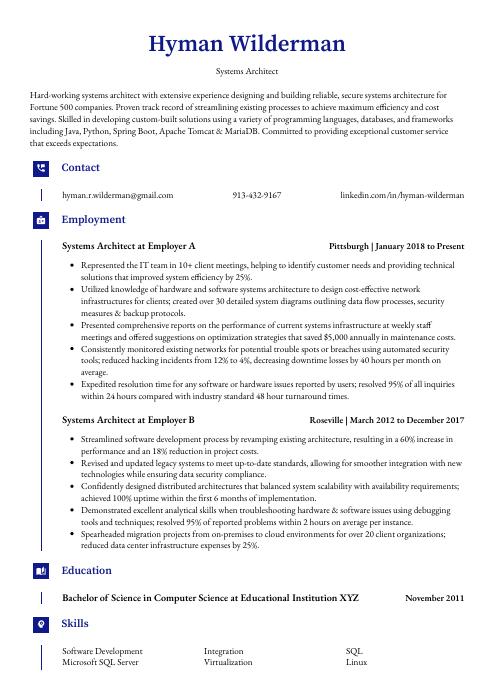 Gharial
Gharial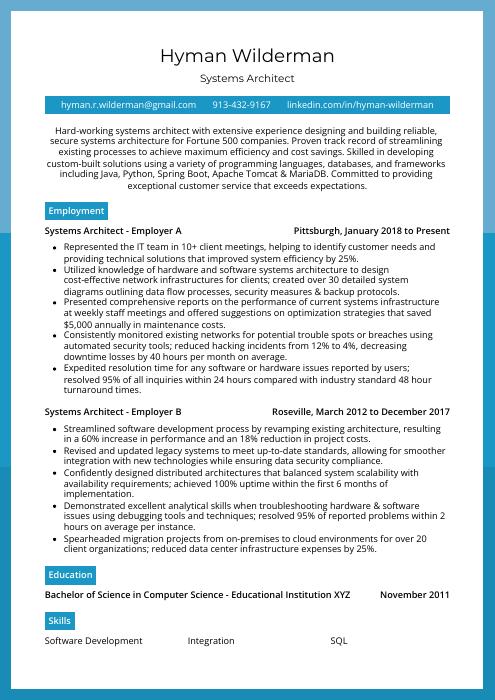 Rhea
Rhea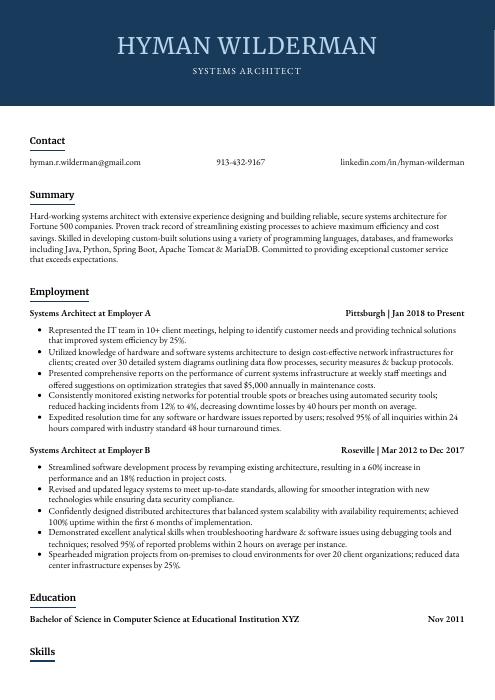 Bonobo
Bonobo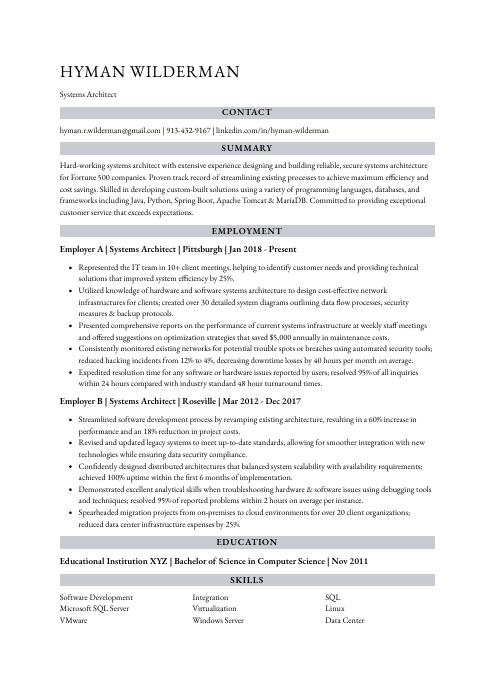 Numbat
Numbat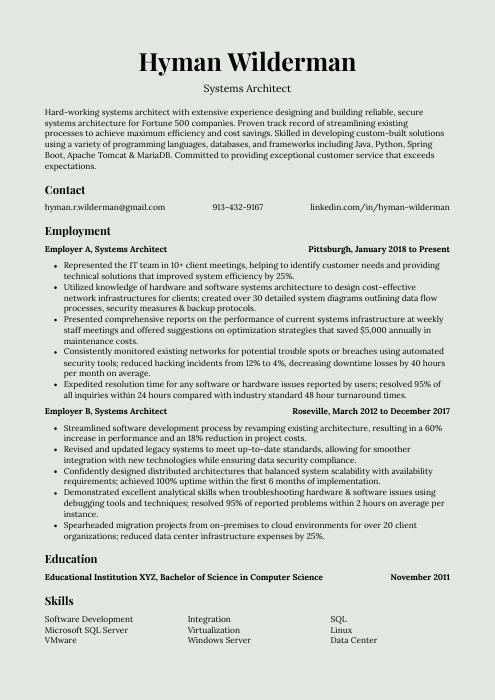 Saola
Saola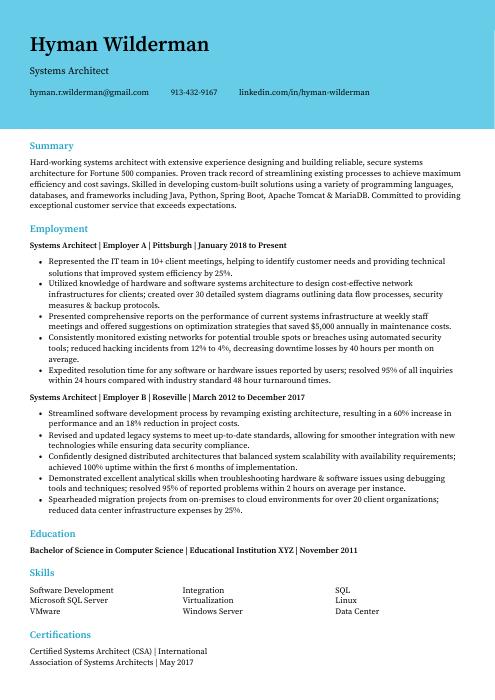 Dugong
Dugong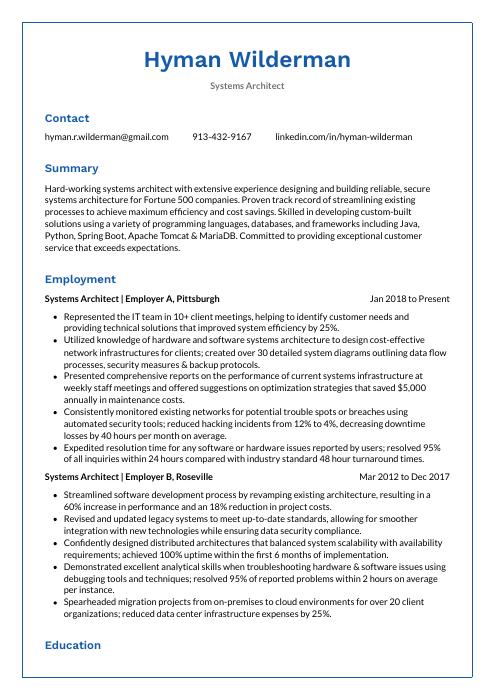 Markhor
Markhor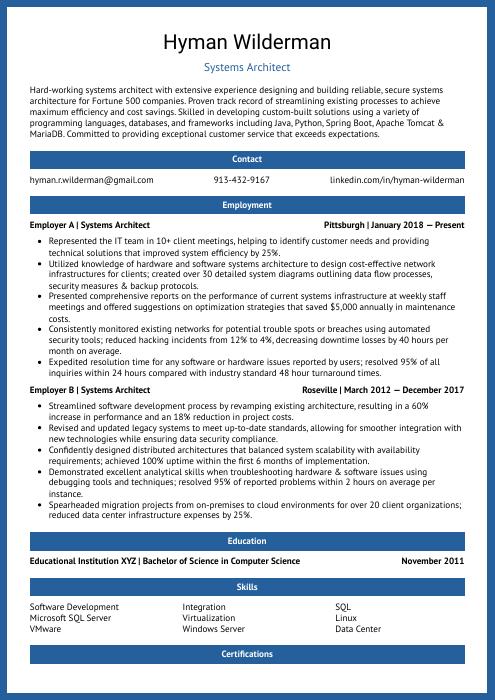 Ocelot
Ocelot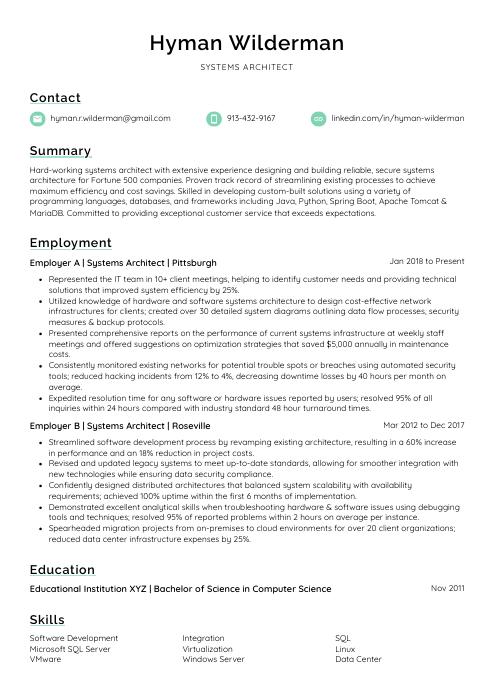 Lorikeet
Lorikeet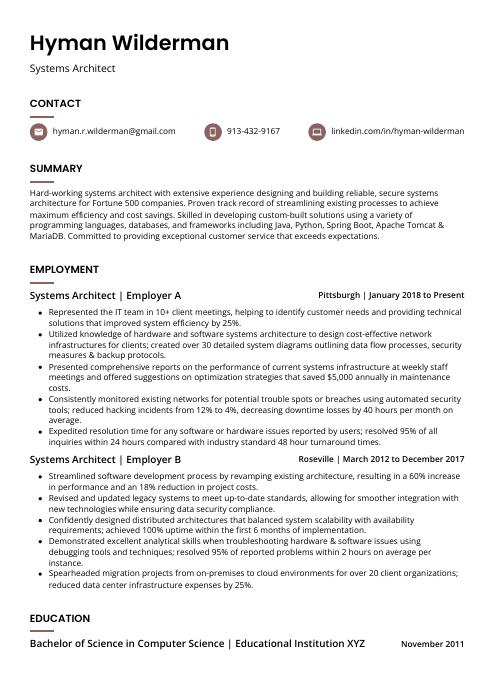 Fossa
Fossa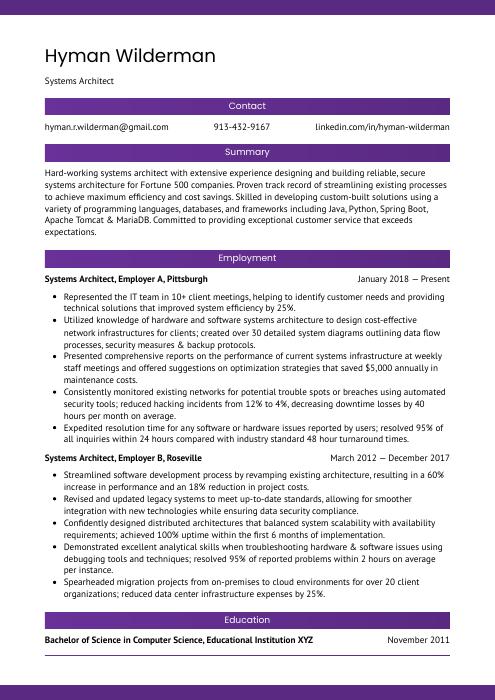 Jerboa
Jerboa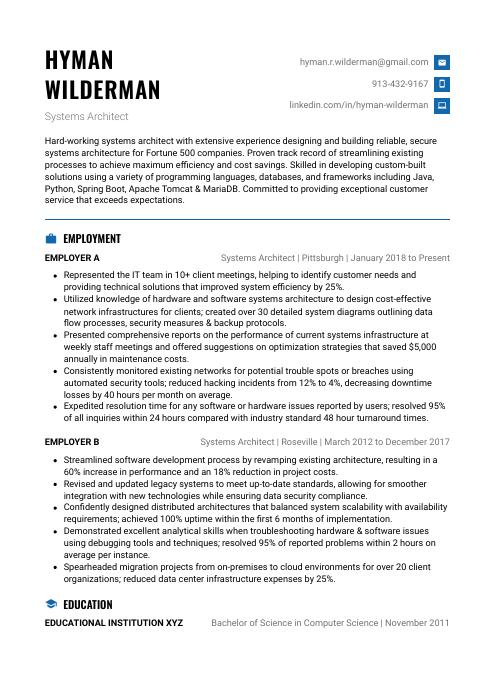 Echidna
Echidna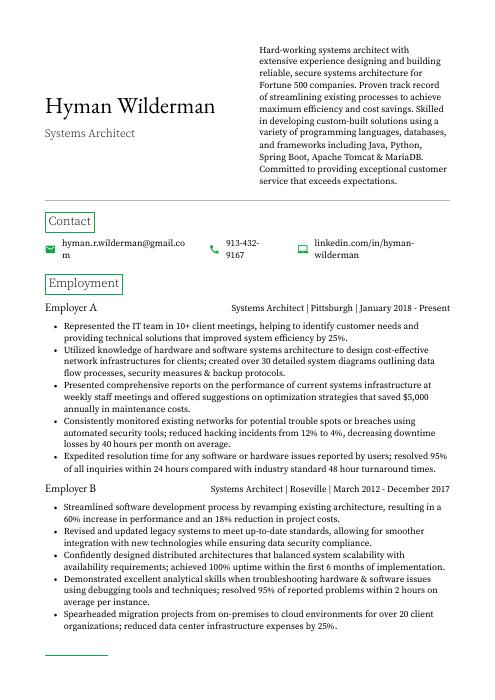 Quokka
Quokka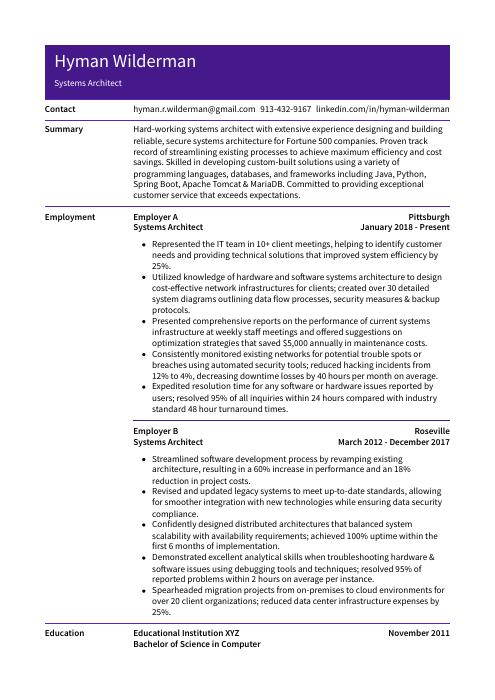 Pika
Pika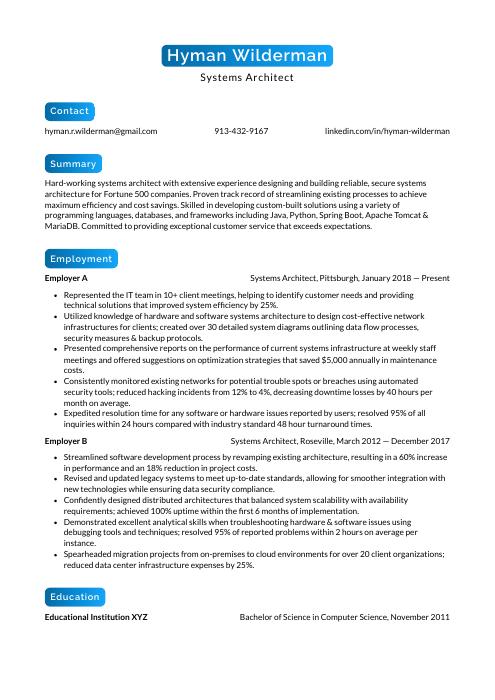 Kinkajou
Kinkajou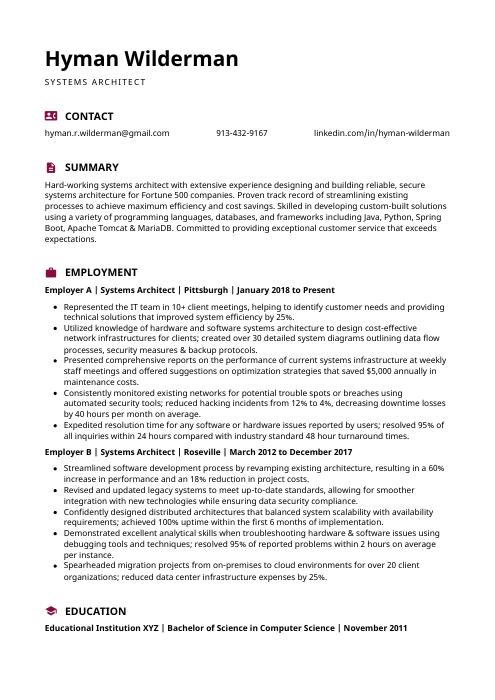 Hoopoe
Hoopoe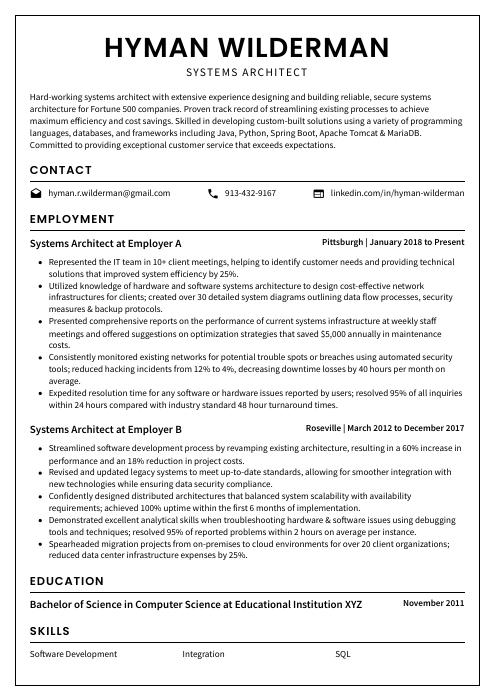 Cormorant
Cormorant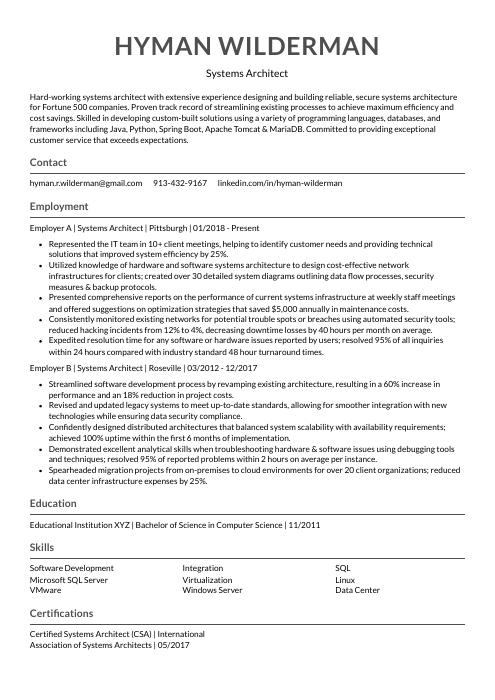 Indri
Indri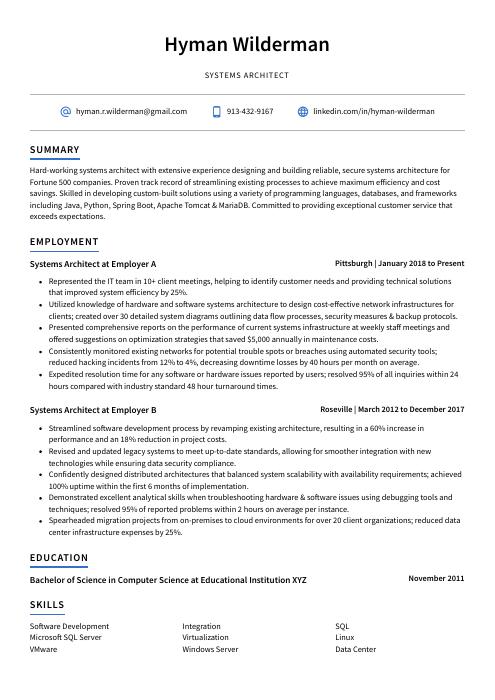 Axolotl
Axolotl Rezjumei
Rezjumei
